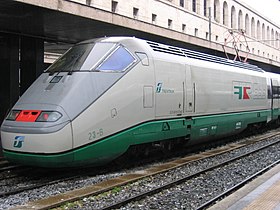FS Class ETR 500
| ETR.500 (mono-current) ETR 500 (bi-current) ETR 500 F (tri-current) |
|
|---|---|

The ETR 500 "Frecciarossa" of the Italian Railways
|
|
| Operator(s) | Trenitalia (current) |
| Specifications | |
| Power supply | (?) |
| Electric system(s) |
Overhead catenary, 3 kV DC, ETR.500 (mono) + 25 kV 50 Hz AC, ETR 500 (bi) + 1.5 kV, ETR 500 F (tri) |
| Current collection method | Pantograph |
| Track gauge | 1,435 mm (4 ft 8 1⁄2 in) standard gauge |
| ETR.500 (mono-current) | |
|---|---|

ETR.500 mono-current powercar at Roma Termini.
|
|
| In service | 1992–2007 |
| Manufacturer | Trevi (consortium of Breda Costuzioni Ferroviarie, FIAT Ferroviaria, Tecnomasio and Firema Trasporti) |
| Refurbishment | 2006–2008, transformation into E.414 |
| Number built | 30 trainsets |
| Formation | 11-car trainset |
| Capacity | 187 (1st class) 469 (2nd class) |
| Operator(s) | FS/Trenitalia |
| Specifications | |
| Train length | 327.6 m (1,074 ft 10 in) |
| Maximum speed | 300 km/h (186 mph) |
| Weight | 598 t (589 long tons; 659 short tons) |
| Power output | 8,800 kW (11,800 hp) |
| Train heating | (?) |
| Electric system(s) |
Overhead catenary, 3 kV DC |
| Current collection method | Pantograph |
| Safety system(s) | RS4, SCMT |
| Track gauge | 1,435 mm (4 ft 8 1⁄2 in) standard gauge |
| ETR 500 (bi-current) ETR F 500 (tri-current) |
|
|---|---|

ETR.500 "AV" at Milano Centrale.
|
|
| In service | 2000 – present |
| Manufacturer | Trevi (consortium of Alstom, Bombardier, AnsaldoBreda) |
| Refurbishment | 2012 (replacing 1st and 2nd class with 4 levels of service) |
| Number built | 30 complete trainsets + 60 power cars (for 1st generation mono-current sets) |
| Number in service | 59 trainsets |
| Formation | power car + 11 middle cars + power car (original-2004, 2011-present) 12 middle cars (2004-2010) 8 middle cars (ETR 500 F, Turin-Milan) |
| Capacity | 11 middle cars: 187 (1st class) 469 (2nd class) 12 middle cars: 195 (1st class) 476 (2nd class) 8 middle cars: 136 (1st class) 268 (2nd class); From 2012: 574 seats. Executive 8 armchairs + meeting room for 6 people (coach 1); Business 159 (coaches 1,2,3,4); Bar- Bistrot (coach 5); Premium 67 (coach 6); Standard 340 (coaches 7,8,9,10,11) |
| Operator(s) | FS/Trenitalia |
| Line(s) served | Torino-Milano-Bologna-Firenze-Roma-Napoli-Salerno; Torino-Milano-Verona-Padova-Venezia-Trieste/Udine; Venezia-Padova-Bologna-Firenze-Roma-Napoli-Salerno; Milano-Bologna-Ancona-Pescara-Bari-(Lecce) |
| Specifications | |
| Train length | 327.6 m (1,074 ft 10 in) (original formation) |
| Maximum speed | 300 km/h (186 mph) |
| Weight | 598 t (589 long tons; 659 short tons) |
| Power output | 8,800 kW (11,800 hp) |
| Power supply | (?) |
| Electric system(s) |
Overhead catenary, 3 kV DC, 25 kV 50 Hz AC (+ 1.5 kV DC for ETR.500 F) |
| Current collection method | Pantograph |
| Safety system(s) | RS4, SCMT, ETCS (+ KVB and TVM430 for ETR.500 F) |
| Track gauge | 1,435 mm (4 ft 8 1⁄2 in) |
ETR 500 (Elettro Treno Rapido 500) is a family of Italian high-speed trains introduced in 1993.
Designed under the aegis of the Ferrovie dello Stato (FS), it is now operated by Trenitalia on RFI tracks.
The opening of the Direttissima line, connecting Florence with Rome, in stages between 1978 and 1991 was the first high speed line in Europe. Then, in the 1990s, FS unveiled plans to build a whole new high speed network. As the larger part of the network would be suited for speeds of 300 km/h (186 mph), new, non-tilting trains had to be designed as the tilting equipment used in the ETR 450, 460 and 480 Pendolino series was not suited for speeds of over 250 km/h (155 mph).
The new train was to be built by the TREVI (TREno Veloce Italiano, "Italian Fast Train") formed by Breda Costuzioni Ferroviarie, FIAT Ferroviaria, Tecnomasio and Firema Trasporti.
In 1988 the first prototype motorcar, called "ETR 500-X" and nicknamed "Remo",as the brother of the first Roman king, rolled out of the factory in Vado Ligure. It was tested on the Direttissima line in the combination of a measuring car and an E 444 locomotive, reaching a record speed of 319 km/h (198 mph).
In 1990 the 2 first complete trainsets, called "ETR 500-Y" and nicknamed "Romolo", as the first Roman king, were delivered. They were used as test units between their delivery and 1995, when the first production sets entered into service.Between 1995 and 1997 they were also used in normal commercial service when there was a shortage of normal ETR.500 trainsets.
The 3 motorcars of the prototype sets are now based at different locations in Italy and unfortunately have been vandalised and graffitized. The middle cars of the 2 "ETR 500-Y" sets are now part of the two RFI ETR.500 test trains Y1 and Y2.
...
Wikipedia
